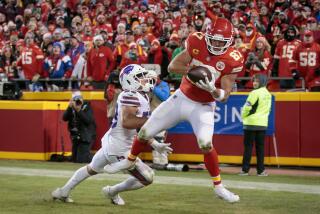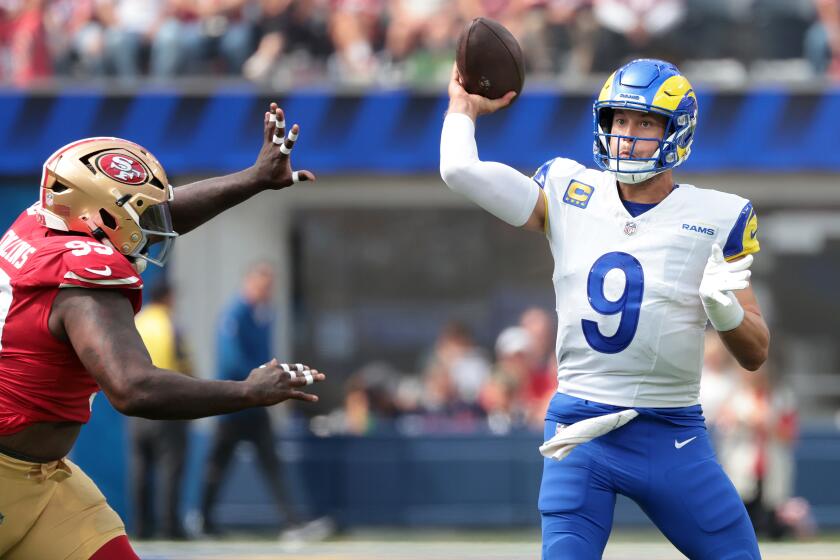NFL replay system is still under review
- Share via
Back when “CSI” helped launch a new breed of forensic science dramas on television, prosecutors complained that real-life cases were being unduly influenced: Jurors walked into courtrooms expecting to see conclusive scientific evidence for every crime.
A similar dynamic has become the talk of the NFL playoffs.
A Green Bay Packers receiver fumbles — or doesn’t fumble — as he falls to the turf. A San Francisco 49ers returner ventures dangerously close to a bouncing punt. A Baltimore Ravens receiver appears to catch a game-winning touchdown pass, only to have it slapped from his hands a moment later.
Even with the help of instant replay — all those camera angles, all that super-slow motion — these and other calls have been hotly debated.
“Usually, I am looking for the most proof I can get,” New York Giants Coach Tom Coughlin told reporters this week. “But we have lost some challenges this year without empirical data.”
Now, with Coughlin’s team headed to Indianapolis to face the New England Patriots in Super Bowl XLVI, the NFL’s system for reviewing calls has come under increased scrutiny.
“When instant replay began, everybody thought we were going to get a piece of film that’s absolutely going to nail it down,” said Barry Mano, president of the National Assn. of Sports Officials. “Guess what? You can look at a clip and I can look at a clip and we can see two different things.”
The NFL has employed some form of instant replay for parts of four decades and, despite lingering complaints about interruptions, no one in or around the game expects the system to go away.
The procedure is simple: When a call is challenged, the referee jogs to the sideline, where he has 60 seconds to view clips before rendering a decision.
Compare this to other sports.
NBA officials similarly watch video at courtside, but in a limited number of situations.
In college football, the onus shifts away from the field, all reviews handled by replay officials in the press box. The NHL takes this notion a step further — goals are analyzed by an on-site official and a specialized crew located in a “situation room” in Toronto.
“We feel it brings us more consistency because it’s the same people making the calls,” said Mike Murphy, the league’s senior vice president of hockey operations. “You may not like the call, but that’s the same one you’re going to see night after night.”
Mano, whose association includes officials from virtually every sport, believes there is an advantage to reviewing plays far from the madding crowd.
“It’s very quiet,” he said. “You can somewhat dispassionately evaluate what’s going on.”
But former official Terry Gierke, a veteran of 21 seasons in the NFL, doesn’t think referees need that sort of help.
“There isn’t that much pressure” in the stadium, he said. “Those guys are used to it.”
Perhaps the most controversial aspect of the current NFL system involves not where, but when. Critics don’t like limiting the number of reviewable plays by giving coaches only two challenges.
NCAA policy allows limited coach challenges but also has officials in the booth scrutinizing every play — and pausing the game if they see a potential reversal. In the NFL, replay officials have that authority only after scoring plays, the two-minute warning and during overtime.
Gierke, who worked three conference championships and a Super Bowl, doesn’t expect that will change.
“The big thing is, they want those games completed in a certain amount of time for TV revenue, which runs the game,” he said of the NFL. “They don’t want a whole bunch of interruptions.”
Still, there has been talk of coaches eventually receiving more challenges. Mike Pereira, the former vice president of NFL officiating who now works for Fox Sports, has called for an adjustment in challenging end zone plays.
The incomplete pass in last week’s Ravens-Patriots game — a close call that ultimately appeared to be correct — was reviewable only because it occurred in the final two minutes. What if a similar play unfolds between the Giants and Patriots next weekend with 2:01 remaining on the clock?
“In my mind,” Pereira recently wrote, “the entire envelope of the end zone should have been made automatically reviewable, regardless of whether a score was ruled.”
But the NFL system seems to have made a fan of NBA Commissioner David Stern, who has suggested his league might switch to a similar model.
“Rather than having a Talmudic discussion between the referees, you might have one person whose job it is to keep the earphones on and always watch,” Stern said last spring. “And you might let a coach drop the flag in the last two minutes.”
If nothing else, instant replay has become theater, fans waiting on the edge of their seats — or complaining about the delay — until the referee hands down his ruling.
The NFL has a long history of tinkering with the system. And with so much discussion over calls in recent playoff games, Mano predicts it will continue to evolve.
“Once the cork came out of the bottle, everybody understood it would need to be managed,” he said. “It ends up being a negotiated peace.”
twitter.com/LATimesWharton
More to Read
Go beyond the scoreboard
Get the latest on L.A.'s teams in the daily Sports Report newsletter.
You may occasionally receive promotional content from the Los Angeles Times.











